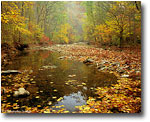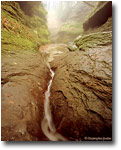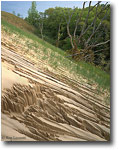 |
Expect the UnexpectedText copyright Christopher Jordan
Images copyright Christopher Jordan and Ron Leonetti
All rights reserved.
Editor’s Note - Thumbnails are links to larger images, presented in slide show format.
One of the most common discussions on this site revolves around the question “Where can/should I go to photograph?” There is a Favorite Locations forum completely devoted to discussions of location, as well as regular questions (at least in the ESS forum, where I spend most of my time) about where a particular shot was taken. I would like to offer some observations based on the recent completion of a project that involved nature/landscape photography in a location high on everyone’s list — Indiana!

Photo 1

Photo 2

Photo 3

Photo 4
|
|
What? You didn’t know Indiana had anything beyond cornfields, basketball, and Indy car racing (not necessarily in that order)? You thought Indiana was one of those “fly-over” states on your way to shooting in Colorado, Utah, or Washington? You’re convinced that the entire state is flatter than your dining room table? Well, perhaps a bit of additional information is in order….
For the past 4 years, I have been spending a significant amount of time exploring the (relatively) small, somewhat hidden natural areas of Indiana. This work has resulted in the publication of Unexpected Indiana: A Portfolio of Natural Landscapes, a coffee table book of landscape and nature photography, authored in collaboration with Ron Leonetti, released in August 2004 by Quarry Books, an imprint of Indiana University Press. Believe it or not, the state has a broad range of interesting areas to explore that provide opportunities for both landscape and wildlife photography. For example:
- The Indiana Dunes National Lakeshore covers 25 miles of Lake Michigan shoreline. While it is only about 15,000 acres in size, it ranks seventh among all national parks in terms of native plant biodiversity (last count included 1418 varieties of vascular plant species in the park boundaries).
- The Hoosier National Forest is spread throughout the southern portion of the state. It includes the 13,000 acre Charles C. Deam Wilderness area, one of the larger federally designated wilderness areas east of the Mississippi.
- The Indiana Department of Natural Resources (IDNR) administers 23 state parks scattered throughout the state, 12 state forests covering over 145,000 acres, 9 reservoirs, and 21 designated fish and wildlife areas.
- Finally, the IDNR and several other agencies own and administer more than 200 nature preserves that protect some of the most fragile, diverse, and spectacular sites within the state. These include preserves owned or administered by the Nature Conservancy of Indiana, ACRES Land Trust, Central Indiana Land Trust, and the Redtail Conservancy (by no means an exhaustive list).
The range of plant life, landforms and ecosystems contained in these various sites is nothing short of amazing. For example, the northern range of the bald cypress tree extends into the tip of southern Indiana (Photo 1), where the Ohio and Wabash rivers meet. This is the northernmost limit of the range of this tree, but several naturally occurring bald cypress swamps are available for visitation and photography in this area. The southern third of Indiana is relatively hilly and includes many sites where sandstone cliffs and box canyons contain beautiful waterfalls and rock faces. Places like Clifty Falls State Park (Photo 2), McCormick’s Creek State Park, and Hemlock Cliffs Recreation Area in the Hoosier National Forest provide photo opportunities that will shock those who think of Indiana as entirely flat. In addition, Brown County State Park is considered by some the crown jewel of the state park system. This 16,000 acre state park provides beautiful forest views, stunning vistas across the hills of southern Indiana, and a fall foliage display that is spectacular.
A similar range of impressive topography is contained in the west-central area, including Turkey Run State Park (Photo 3), Shades State Park, and Pine Hills Nature Preserve. Turkey Run contains some impressive cliffs and canyons, seasonal waterfalls and the beautiful Sugar Creek, surrounded by one of the larger old growth forests remaining in Indiana. Smaller nature preserves such as Fall Creek Gorge and Portland Arch also protect some outstanding examples of the beautiful topography that can be found in this part of the state.
Further north, the southern range of the tamarack tree dips into northern Indiana. These trees can be found in several nature preserves such as Olin Lake Nature Preserve and Ropchan Memorial Nature Preserve. Both Potato Creek State Park and Pokagon State Park contain fascinating wetlands areas and Pokagon also harbors a lovely kettle lake adjacent to the wetlands. The Indiana Dunes State Park and National Lakeshore (Photo 4) is a true national treasure that provides a broad range of ecosystems and photographic opportunities, including forests, savannahs, wetlands, dunes, and Lake Michigan itself.
What, then, is the point of my waxing poetic about a whole range of places that almost no one on this site will ever visit more than once (regardless of my online enthusiasm). The point is that these are all wonderful places to spend time photographing, and I know about them because I went looking for them close to home. One of the things I’ve learned time and again on this project is that Nature (capital N) is a wonderful and amazing thing no matter where you find her. No one will ever confuse the hills of southern Indiana for true mountains, and while the Indiana Dunes do have sand dunes and prickly pear cactus it’s not likely that the area will pass for a true desert any time soon. None of that matters. The opportunities for solitude, relaxation, study of the diversity and complexity of the natural world, and outstanding photography exist anywhere that nature has been allowed primary control of the landscape. Many of the sites in Unexpected Indiana are not large, yet they retain a beauty and a primitive feel that cannot be explained but is easily felt.
Based on all this, here are a few personal observations for your consideration. As always, your mileage may vary on all of these but hopefully something here will challenge or inspire.
- Learn your local landscape. It may not be Half Dome or slot canyons, but with patience and repeated exposure it will surely yield subject matter of interest. I firmly believe that getting to know a place in great detail, in all seasons and all weather is much more likely to yield high quality photographic results than trophy hunting at the photographic hot spots that attract hordes of photographers. In most cases my favorite images have come from repeated visits to the same place.
- Avoid the “grass is greener” syndrome. I’ve lost track of the number of times I’ve seen someone refer to needing to go to site X because the landscape where they live is not as spectacular/interesting/dramatic as that place. Frankly, I believe this is short-sighted and does not demonstrate a receptive attitude to the many different types of beauty that are available. If you think you have to go somewhere else, I challenge you to look more closely at your own backyard. Really, if all of the above interesting places can be found in Indiana then it can’t be any different around your hometown.
- Practice makes perfect, or at least makes you better than you were. If your only experience comes from trips to the hot spots, you are unlikely to improve your photography significantly, unless you have unlimited time and travel budget. Just like playing a musical instrument, you must practice regularly to improve, engaging in activities that stretch your limits. This is simply easier and can be done more consistently if you practice point #1.
- Finally, to know a place is to love it. Most of the natural areas that exist in this country are under some sort of threat to their continued existence, regardless of size. The more aware you are of the special places around you, the more informed and interested you are likely to be in the preservation of those places. This benefits everyone now and in the future.
So the next time you are struggling with the question “Where should I go to photograph?” pull out your local map, find somewhere close you’ve never been before, open your mind, and go exploring. There’s an excellent chance you’ll get an unexpected surprise.
CJ-NPN 1207
About the author...
Christopher Jordan has been photographing hidden natural treasures in Indiana and surrounding states for more than 6 years. His online portfolio can be viewed at members.photoportfolios.net/ChristopherJordan. Additional information on Unexpected Indiana can be found at http://iupress.indiana.edu or at Amazon.com.
Comments on NPN creative nature photography articles? Send them to the editor.


|



